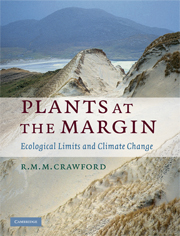Crossref Citations
This Book has been
cited by the following publications. This list is generated based on data provided by Crossref.
2008.
Books and Monographs Received Through July 2008.
Ecology,
Vol. 89,
Issue. 12,
p.
3555.
Ballantyne, Colin Kerr
2008.
After the Ice: Holocene Geomorphic Activity in the Scottish Highlands.
Scottish Geographical Journal,
Vol. 124,
Issue. 1,
p.
8.
Wieser, Gerhard
Matyssek, Rainer
Luzian, Roland
Zwerger, Peter
Pindur, Peter
Oberhuber, Walter
and
Gruber, Andreas
2009.
Effects of atmospheric and climate change at the timberline of the Central European Alps.
Annals of Forest Science,
Vol. 66,
Issue. 4,
p.
402.
Kullman, Leif
and
Öberg, Lisa
2009.
Post‐Little Ice Age tree line rise and climate warming in the Swedish Scandes: a landscape ecological perspective.
Journal of Ecology,
Vol. 97,
Issue. 3,
p.
415.
Holderegger, Rolf
and
Thiel‐Egenter, Conny
2009.
A discussion of different types of glacial refugia used in mountain biogeography and phylogeography.
Journal of Biogeography,
Vol. 36,
Issue. 3,
p.
476.
Kozlowski, Gregor
Bürcher, Sandra
Fleury, Matthieu
and
Huber, Fanny
2009.
The Atlantic elements in the Swiss flora: distribution, diversity, and conservation status.
Biodiversity and Conservation,
Vol. 18,
Issue. 3,
p.
649.
2009.
The Flora of Rum; An Atlantic island Reserve.
Botanical Journal of the Linnean Society,
Vol. 160,
Issue. 4,
p.
442.
Antonovics, Janis
2009.
The effect of sterilizing diseases on host abundance and distribution along environmental gradients.
Proceedings of the Royal Society B: Biological Sciences,
Vol. 276,
Issue. 1661,
p.
1443.
Saarinen, Timo
and
Lundell, Robin
2010.
Overwintering of Vaccinium vitis-idaea in two sub-Arctic microhabitats: a reciprocal transplantation experiment.
Polar Research,
Vol. 29,
Issue. 1,
p.
38.
Wagner, Johanna
Steinacher, Gerlinde
and
Ladinig, Ursula
2010.
Ranunculus glacialis L.: successful reproduction at the altitudinal limits of higher plant life.
Protoplasma,
Vol. 243,
Issue. 1-4,
p.
117.
Lütz, Cornelius
2010.
Cell physiology of plants growing in cold environments.
Protoplasma,
Vol. 244,
Issue. 1-4,
p.
53.
Remias, D.
Albert, A.
and
Lütz, C.
2010.
Effects of realistically simulated, elevated UV irradiation on photosynthesis and pigment composition of the alpine snow alga Chlamydomonas nivalis and the arctic soil alga Tetracystis sp. (Chlorophyceae).
Photosynthetica,
Vol. 48,
Issue. 2,
p.
269.
Hill, Nicholas M.
and
Garbary, David J.
2011.
Habitat may limit herb migration at the northern edge of the Appalachian deciduous forest *This paper is dedicated to our botanical mentor, the late Dr. Sam P. Vander Kloet..
Botany,
Vol. 89,
Issue. 9,
p.
635.
Csergő, Anna‐Mária
Molnár, Edit
and
García, Maria Begoña
2011.
Dynamics of isolatedSaponaria bellidifoliaSm. populations at northern range periphery.
Population Ecology,
Vol. 53,
Issue. 2,
p.
393.
Bates, Jeffrey W.
and
Preston, Christopher D.
2011.
Bryophyte Ecology and Climate Change.
p.
371.
Hodkinson, T. R.
2011.
Climate Change, Ecology and Systematics.
p.
3.
Hodd, R. L.
and
Sheehy Skeffington, M. J.
2011.
Climate Change, Ecology and Systematics.
p.
490.
Gajewski, Konrad
2011.
Changing Cold Environments.
p.
48.
Maynard, Clare
McManus, John
Crawford, Robert M.M.
and
Paterson, David
2011.
A comparison of short-term sediment deposition between natural and transplanted saltmarsh after saltmarsh restoration in the Eden Estuary (Scotland).
Plant Ecology & Diversity,
Vol. 4,
Issue. 1,
p.
103.
HARTMANN, HENRIK
2011.
Will a 385 million year-struggle for light become a struggle for water and for carbon? - How trees may cope with more frequent climate change-type drought events.
Global Change Biology,
Vol. 17,
Issue. 1,
p.
642.





